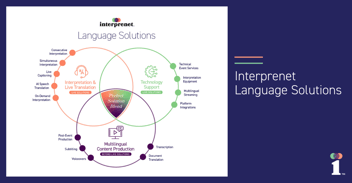.png)
For over 60 years, there have been efforts to automate the translation and interpretation process. With the development of Computer Assisted Translation, linguists can develop glossaries and Translation Memory (TM) which aids and enhances the translation process by reducing the time it takes to complete a translation and catering to client or industry specific terms and concepts. In the language industry, we call this Machine Translation (MT) (text-to-text) and Machine Interpreting (MI) (speech-to-speech).
Computer Aided (or Assisted) Interpretation (CAI) is a technology support tool, more specifically a computer software that assists professional human interpretation. It assists with the preparation and delivery of interpretation, enabling human interpreters to be more effective and organized. Most typically, we see CAI in Simultaneous Interpretation Sessions.
Computer-Assisted Interpretation (CAI) Helps Interpreters With:
1. Assist interpreters to prepare for assignments
Interpreters have always used lists of terms and manual processes to prepare for interpretation sessions. CAI’s software helps to streamline terminology management for interpreters to prepare for their upcoming interpretation session.
CAI at its core functionality supports preparation by creating and managing databases of specialized terms, glossaries, and dictionaries for quick access. This helps eliminate the manual process of searching for a term during live interpretation which otherwise reduces focus on actual interpretation and takes up brain bandwidth.
2. Assistance during the delivery of assignments
When an interpreter uses CAI software, the addition of speech recognition helps interpreters with real-time transcription of spoken language. This allows them quickly reference their terminology database. Auto-transcription also shows numbers and proper names which reduces the need for notetaking.
Notetaking in interpreting is a specialized skill that interpreters develop over time and with training; it can be challenging and take years to master. It’s used heavily for consecutive interpretation, but can also be used in simultaneous settings.
3. Support post-assignment
After an assignment is complete, interpreters can look back at data, edit and maintain their database and perform quality assessments. With the exponential increase and prevalence of remote simultaneous interpretation interpreters are relying more and more on technology and artificial intelligence to support their work.
CAI Benefits for Interpreters: More Than Just a Dictionary
CAI offers a multitude of benefits for interpreters, including:
- Increased Accuracy: Accessing terminology databases and real-time speech recognition helps minimize errors and ensure precise interpretations.
- Improved Efficiency: Automation of tasks like terminology lookups and note-taking frees up mental bandwidth, allowing interpreters to focus on the nuances of communication.
- Enhanced Consistency: Maintaining consistent terminology and style across interpretations, especially in long or complex sessions.
- Reduced Stress: CAI tools can alleviate the cognitive load, reducing mental fatigue and improving overall well-being.
- Expanded Opportunities: Remote interpretation platforms have opened up new avenues for interpreters to work with clients worldwide.
Real-World Applications: CAI in Action
Let's explore three concrete examples of how interpreters leverage CAI in their work:
-
Medical Interpreting:
- Imagine an interpreter facilitating communication between a doctor and a patient with limited English proficiency.
- CAI tools allow the interpreter to quickly access a medical terminology database, ensuring accurate translations of complex medical terms.
- Speech recognition can also transcribe the doctor's instructions, providing a visual aid for the patient and helping the interpreter maintain accuracy.
-
Conference Interpreting:
- During a large international conference, interpreters often face a barrage of technical jargon and specialized terminology.
- CAI platforms enable interpreters to create and share glossaries in real-time, ensuring consistency among the interpreting team.
- Also, the integration of remote interpreting platforms allows for seamless relay interpreting, where one interpreter listens to another interpreter.
-
Legal Interpreting:
- In legal settings, precision and accuracy are paramount.
- CAI tools can help interpreters manage legal terminology, access relevant case law, and maintain detailed notes.
- Also, many legal systems are using secure online platforms that integrate CAI features to facilitate remote court hearings.
The Future of Interpretation: Embracing Technology
CAI is not about replacing human interpreters; it's about augmenting their capabilities and empowering them to excel in their profession. As technology continues to evolve, we can expect even more sophisticated CAI tools to emerge, further transforming the landscape of interpretation.
By embracing these technological advancements, interpreters can enhance their skills, expand their reach, and continue to play a vital role in bridging communication gaps across languages and cultures.
👇

%20(1).png?width=352&name=Blog%20Featured%20Images%201200%20x%20627%20(1)%20(1).png)

